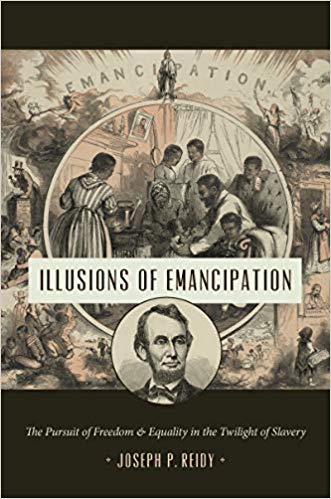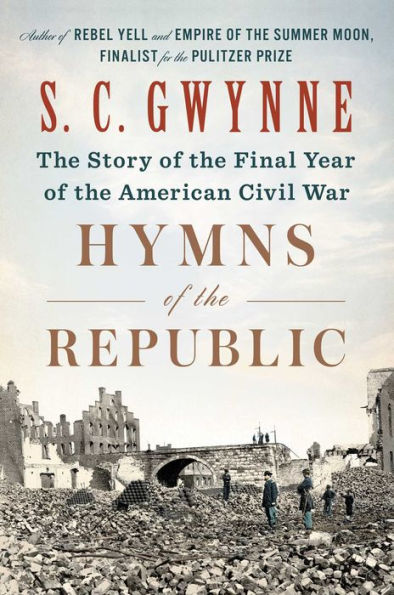Joseph P. Reidy, Professor Emeritus of History at Howard University, is an acknowledged authority on slavery and emancipation in the U.S. Thus, it is fitting that he received the assignment to write the volume that examines the death of slavery for the University of North Carolina Press’s Littlefield History of the Civil War Era. Illusions of Emancipation, he observes, “begins with the simple assertion that emancipation was a complex and uneven process rather than a specific event, and that it drew into its vortex as historical actors from all regions of the country and backgrounds, most significantly enslaved Southerners and free African Americans in the North as well as the South” (13).
Like many historians of slavery and emancipation, Reidy does not see a single point, a single event, or a single historical figure as responsible for emancipation. For that matter, he also does not see a linear trajectory leading to emancipation. As one might expect, he includes a diverse cast of characters in his analysis, ranging from well-known people such as Abraham Lincoln, Edward Philbrick, Charlotte Forten, and Frederick Douglass to more obscure folk who left far fewer traces on the historical record. Reidy proposes three overlapping frameworks to explain how the Civil War generation made sense of the chaos and possibilities of war and emancipation: time, space, and home. In reference to the title he writes, “this book examines slavery through the sometimes clear and sometimes foggy lenses with which contemporaries saw their world. It explores the illusory aspects of emancipation that often perplexed participants and witnesses at the time and later observers alike” (20).
Reidy divides the volume into three parts, each containing three chapters. Part I deals with time, which, “may be irregular, messy, and unpredictable as well as straightforward and evenly paced” (24). The three chapters analyze, respectively, chronological or linear time, seasonal or recurring time, and erratic or revolutionary time. Chronological time is usually convenient for historians because it can serve as a framing device to reduce complexity. However, as he observes, “neither the narrative arc of ‘The Age of Emancipation’ nor the chronology of events in any one of the polities where slavery came to an end during the nineteenth century supports the notion of a steady march to extinction” (28). Chronological time, although important, can be deceiving and misleading. That said, it was not the only way people had of understanding time. Many people understood events in terms of seasons. Slaveowners, for example, saw the arrival of U.S. forces as a form of death, but for the freed people this arrival appeared “as a rebirth, coinciding perfectly with the season for new life” (87). However, that rebirth did not last as long as many people would have liked and “the springtime of freedom led to the summer of Radical Reconstruction, which was followed by the autumn of Redemption, and the winter of segregation and disfranchisement” (88). People also thought about time on a broader scale, in terms of revolutions, a word that had considerable meaning for people in the nineteenth century due to a rich heritage of revolutions. In the midst of the chaos of war and the powerful changes it produced, people saw themselves as being buffeted by forces over which they had little control and “time itself appeared to behave erratically in the revolutionary vortex” (95). Reidy successfully explains how people conceived of many different types of time.
Part II turns to space, particularly how war transformed space on both small and large scales. Reidy first considers big transformations in big spaces, noting, “emancipation unfolded through space, with contours that were as vast as they were varied” (129). He charts the transformation of the U.S., particularly the slow death of slavery in some localities and its more rapid demise in others. The war also transformed small spaces as well. These small spaces ranged from locations such as the House and Senate chambers of the U.S. Congress, the White House, and the War Department to “the context of each individual slaveholding” (162). The final chapter explores how military operations altered the built environment and the social landscape. Slaveholders in rebeldom felt themselves under siege from both U.S. forces and their fellow rebels. Indeed, “from the Atlantic Ocean to the Rio Grande, the war created unprecedented circumstances wherein the authority of slaveholders was subject to challenge by not just one but two competing governments” (218). Slaves took advantages of the changes produced by the war and altered space through escape or strategic waiting. As Reidy concludes, “far from fixed and precisely definable, the land of freedom, like freedom itself, possessed the property of motion” (225).
Part II analyzes emancipation through the prism of home. People seek stability in times of upheaval and “home” resonated during the war’s turbulent years. Reidy begins with a question that obsessed many people at the time: “what shall we do with the Negro?” The war produced many different answers. Reidy focuses on refugees and contrabands and notes how “work altered the relationship between the government and the refugees” (238). He also analyzes several different rehearsals for Reconstruction and how many people tried to graft northern ideas about free labor onto the freed people. The second chapter examines the efforts of the freed people to build new lives. “Tens of thousands of freedom seekers,” Reidy observes, “undertook the journey from slavery to freedom, undergoing the transformation from persons dependent on their owners into new men and women” (267). Furthermore, the war undermined “every definition of home derived from the model of the slaveholding household” (269) and freed people understood that their transitions from slavery to freedom necessitated forging new social relationships. The final chapter considers the struggles of free black people in the North to achieve equality. Here Reidy analyzes divergent attitudes about military service, the promises and perils of emigration, and the intense struggle for civil rights and against second-class citizenship in the northern states.
In a brief epilogue, he concludes, “as wartime emancipation makes clear, the human struggle for freedom and equality lends itself to illusions. Time may move erratically; space may shift; and the sense of belonging to social networks that all humans crave—family, neighborhood, community, polity—may prove ephemeral” (356).
Illusions of Emancipation is an important book. As one of the field’s senior scholars, Reidy brings to bear decades of immersion in the relevant primary sources, first as a member of the Freedmen and Southern Society Project at the University of Maryland, and then as a faculty member at Howard University. He also demonstrates an impressive mastery of the secondary literature. This powerfully written and deeply researched book—not to mention an important contribution to the Littlefield Series—will be welcomed by scholars who are just beginning their study of slavery in the U.S. as well as specialists.
Evan C. Rothera is co-editor of The War Went On: Reconsidering the Lives of Civil War Veterans, forthcoming with Louisiana State University Press.





